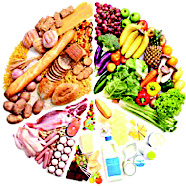
Vibrant health seems to be more accessible to the gourmet, who appreciates food, than the gourmand, who gorges on food.. We should eat foods that are best suited for our body-type and specific lifestyle; with such food, even less is more (healthy). The ‘net’ amount of nutrients available to our body, for helping us carry out our activities and building our health, can vary substantially between different foods. This is referred to as ‘Bioavailability’. It can also be impacted by variables related to our own self, such as age, our body constitution, activity level and general state of health. Added to this are variables that relate to the attitude and methods we adopt to procure, cook and consume food. This in turn impacts the presence or absence of certain substances, which can either help or hurt the absorption of nutrients. In general, the bioavailability of macronutrients – such as carbohydrates, proteins and fats – is usually high (at more than 90% of the amount consumed). However, the absorption of essential micronutrients – such as vitamins and minerals and bioactive phytochemicals (flavonoids, carotenoids) – can vary substantially, which leads to poor immunity, disease, premature ageing and sometimes even death. A particular lookout needs to be kept for calcium, magnesium, iron, zinc, folate and Vitamin A. Understanding bioavailability is important, not only for vulnerable groups such as pregnant and nursing mothers or convalescents, but also during specific stages such as the growing-up years. As we age, although our body needs lesser quantity of food, absorbing and utilising the right amount of nutrients and vitamins from the few foods or supplements we eat becomes all that much more important. For our body to absorb and make good use of nutrients, we should first break up the composites into simpler easy-to-digest parts - by chopping the food before preparation or masticating it well through proper chewing. Thereafter, the food needs to be well digested with the help of gastric juices (acids in the stomach and over 150,000 enzymes in the intestines). This can be impacted by the methods of cooking as well as the presence or absence of either enhancers or inhibitors in the diet.
Tip of the Week
Cooking is required not only for destroying infectious micro-organisms and enhancing palatability, but also for releasing the nutrients from the cell matrix and helping to neutralise some natural toxicants that may be present. The overall impact is on the taste, texture, flavour, digestibility and assimilation of the food. However, like all good things, over-cooking is an all too easy trap that we can fall into. Some nutrients are heat-sensitive (especially fruits), while for others(especially vegetables, legumes, meats, fish, grains and cereals) slow cooking at low heat improves the bioavailability of various essential nutrients. The best example is the bioavailability of carotenoids from vegetables/leafy greens, particularly in the presence of some amount of good quality fat or oil. Boiling, steaming and blanching of vegetables have different effects on different types of nutrients and the amounts of nutrient loss. So does microwaving and sautéing. In general, slow cooking, steaming, convection, baking and selective grilling of fresh food are superior. Boiling is good for soups, stews and curries, and for iron availability. Roasting, heavy grilling or deep-frying are to be avoided, as high-heat cooking methods that brown, darken or dry out foods lead to the formation of carcinogenic (cancer-causing) acrylamides. Generally, ‘quick-steaming’ is best, because it makes beneficial nutrients more absorbable, while causing minimal damage to heat-sensitive ones. Ideally, each food type must be matched with its best cooking method. Many overly processed industrial foods have high concentrations of undesirable products, such as trans fats and high-fructose corn syrup. Further, mere supplementation by ‘added vitamins’ may not in every case assure bioavailability.
Natureís Wonder Food(s) of the Week : Higher Bioavailability combinations
As a classic example of the importance of the right food at the right time and in the right company, there are several pairings that can either enhance bioavailability or act against it. The interaction between different dietary components at the site of absorption can change bioavailability. Enhancers can act in different ways, such as keeping a nutrient soluble or protecting it from inhibitors. Some examples are :
- Inulin, a soluble fibre, which also stimulates the growth of healthy bacteria in the large intestine. According to the American Journal of Clinical Nutrition it may also boost Calcium absorption. Inulin is naturally found in onions, garlic, wheat, bananas and artichokes
- Probiotics, from fermented dairy products such as yogurt, which help improve the bioavailability of Calcium
- Carotenoids and Vitamins A, D, E and K, which are fat-soluble; adding small quantities of fat or oil to the meal improves their bioavailability
- Meat, fish and poultry, which can enhance the absorption of iron from all foods, in addition to offering easily absorbed Heme-iron of their own
- Amino acid Methionine (from lean meats, poultry, fish, eggs, dairy, quinoa, sesame seeds and some nuts e.g. Brazil), which helps improve the bioavailability of Zinc.
Conversely, Inhibitors may reduce nutrient bioavailability by altering some aspect of the complex chain of interactions. Many prescription drugs can interfere with the body’s ability to absorb nutrients. Phytic Acid, which is highly abundant in pulses, whole-grain cereals, seeds and nuts, can bind minerals such as calcium, iron and zinc in soluble or insoluble complexes, making them unavailable for absorption. Ways to reduce the Phytic Acid content of foods include the fermentation or soaking and sprouting of beans, lentils or nuts.
For Education purposes only; always consult a Healthcare Practitioner for medical conditions
Read More...